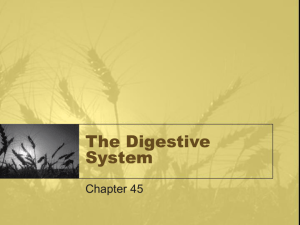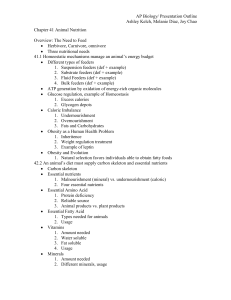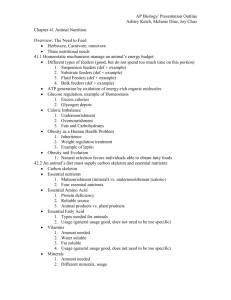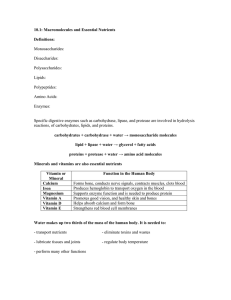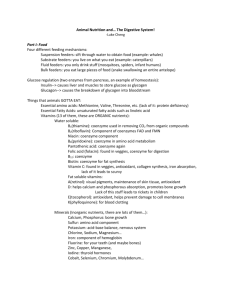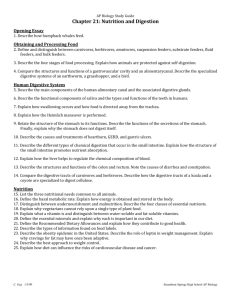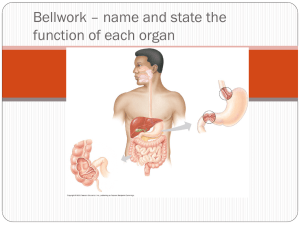AP Biology Chapter 41 Powerpoint
advertisement
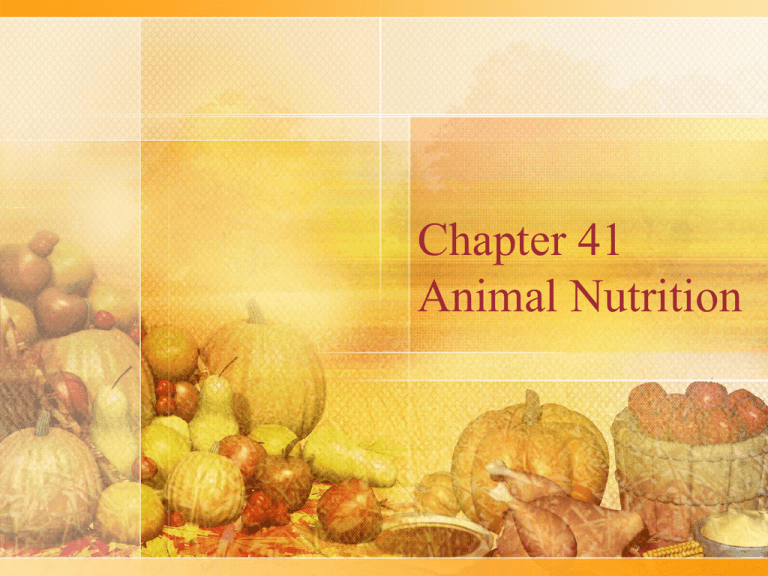
Chapter 41 Animal Nutrition Types of Feeders • Suspension feeders sift through water to obtain small food particles • Fluid feeders suck nutrients from a host • Substrate feeders live on their food sources • Bulk feeders eat large pieces of food Nutritional Needs To function properly an animal needs to consume… • Fuel. • Organic raw materials for biosynthesis. • Essential nutrients which can’t be synthesized through biosynthesis. Fuel • Animals synthesize ATP from other fuel sources and use ATP to power many bodily functions. • Animals oxidize carbohydrates, fats, and proteins in that order as fuel for ATP synthesis. • Severe situations regarding fuel consumption are… – Undernourishment, a prolonged caloric deficit. – Overnourishment (obesity), a prolongued surplus of fat in a diet Raw Organic Materials • An Animal needs to synthesize complex chemicals needed to function. This is called biosynthesis. • Carbon skeletons and sources of organic nitrogen are necessary to synthesize these molecules • These are readily available in the environment Essential Nutrients • Essential Nutrients are important to bodily function but cannot be synthesized by the animal. An animal’s diet must provide these. – Essential amino acids: 8 different monomers necessary for protein synthesis – Essential fatty acids: Certain unsaturated fatty acids. – Vitamins: 13 different organic molecules which have a wide array of bodily uses. They can be either water soluble or fat soluble. – Minerals: Inorganic compounds • Malnutrition arises when an animal lacks essential nutrients. Regulation • Glucose Regulation is controlled by the antagonistic hormones insulin and glucagon. – Insulin: Stimulates blood glucose levels to drop – Glucagon: Stimulates blood glucose levels to rise • Hunger Regulation is controlled by four hormones – Leptin, Insulin, and PYY suppress appetite – Ghrelin increases appetite Food Processing Food Processing • • • • Step 1: Ingestion of nutrients Step 2: Digestion of macromolecules Step 3: Absorption of monomers Step 4: Elimination of undigested waste Types of Digestion • Intracellular digestion occurs when food is digested in the vacuoles of cells • Extracellular digestion occurs when some food is digested in designated cavities outside of cells. • There are two types of digestive cavities – The gastrovascular cavity is a sac with a single opening – The complete digestive tract (alimentary canal) has two openings. Food only moves in one direction. This cavity contains more specialized compartments for digestion. • Hydrolytic Enzymes break down polymers and are used in all types of digestion The Mammalian Digestive Tract The Oral Cavity, Pharynx, and Esophagus • During chewing in the oral cavity, salivary amylase helps break down carbohydrates • After chewing the tongue shapes the food into a bolus • The food is swallowed into the Pharynx (throat) next – The Pharynx opens to the trachea and esophagus • The epiglottis covers the trachea when swallowing • Peristalsis (rhythmic smooth muscle contraction) moves the food down the esophagus The Stomach • A sphincter called the cardiac orifice regulates entrance to the stomach. • The stomach secretes gastric juice. – This mixes with the food to form acid chyme. • The acidity of the gastric juice activates the hydrolytic enzyme pepsin • The pyloric sphincter regulates flow of acid chyme into the small intestine The Small Intestine • The first 25 cm of this is the duodenum. In the duodenum… – Juices from the Pancreas buffer the acid chyme. – The liver secretes bile salts to help digest fats – The epithelium contains and secretes hydrolytic enzymes • Structures in the epithelium called villi and their appendages called microvilli help absorb nutrients – In the villi are capillary beds and lacteals from the circulatory and lymphatic systems respectively – The lacteals drain into larger lymphatic vessels – The capillary beds drain into the hepatic portal vein of the liver The Large Intestine (Colon) • A sphincter in a T-shaped junction controls the entrance into the Large Intestine • The colon reabsorbs most of the water which the small intestine left in the mixture • Undigested material moves through the colon by way of peristalsis into the rectum – The undigested material is now known as feces and is soon discarded Evolutionary Adaptations to the Digestive System • Carnivores have developed sharper teeth while herbivores have developed broader and more rigid teeth • Herbivores have developed longer digestive tracts • Herbivores have developed symbiotic relationships with bacteria that digest cellulose



